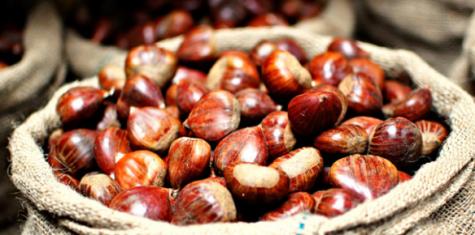They’re not native to Australia, but chestnuts have been grown here for more than 150 years when they were introduced in the Gold Rush era – yet more than a third of the population has never tasted them even though we produce 1,500 tonnes of them each year.
Those who do know what they taste like say you don’t know what you’re missing out on.
For chef Stefano Manfredi, chestnuts are part of his heritage, just as they are for many of our migrant groups from Europe and Asia.
“I grew up eating chestnuts, and despite what some people think, they’re incredibly versatile and simple to prepare,” says Manfredi of Osteria Balla Manfredi at The Star and Manfredi at Bells restaurant at Killcare.
Chestnuts are cholesterol free and relatively low in calories compared with many other nuts and seeds. They have half the calories of roasted cashews and are also low GI, which means the body digests them slowly, keeping you satiated for longer.
They are an excellent source of vitamin C, folate, and minerals such as calcium, magnesium, zinc, iron and potassium. Chestnut flour and meal are gluten free and suitable for those with intolerance and coeliac disease.
The Australian chestnut season begins in March and runs through to July.
“The simplest way to eat chestnuts is as a delicious snack. Just make a small incision on the flat side of the chestnut to prevent bursting. Roast in the oven, on the barbeque or under a grill, and then peel while still warm,” says Manfredi.
Although chestnuts are typically eaten in savoury dishes, Manfredi suggests getting creative with this versatile nut.
“Chestnuts are a fantastic all-round ingredient. They are delicious sliced into salads or boiled as an alternative to pasta or potatoes. You can even puree boiled or roasted chestnuts to stir into soups to add thickness. Chestnut puree also lends itself beautifully to desserts like tiramisu, tortes and cakes,” he says.
“The texture of a cooked chestnut is like that of a baked potato, soft and crumbly. The taste is unique and nutty but subtle, which is why they work so well for both sweet and savoury dishes,” continues Manfredi.
“Chestnuts pair well with fresh ricotta cheese and baked pumpkin for a late summer, early autumn salad,” says Manfredi.
“Boil scored whole chestnuts in water for five minutes and peel while still warm. Stack cubes of oven roasted pumpkin on a plate, spoon ricotta around and scatter sliced boiled chestnuts on top. Garnish with sage leaves and a sprinkling of sesame seeds and you’ve got a wonderful, quick meal.”
Unlike money, chestnuts grow on trees, and can be found in areas such as north-east Victoria, the Dandenong Ranges outside Melbourne, Batlow and the southern tablelands in NSW, in the Adelaide Hills and Manjimup in WA.
“The chestnut harvest this year is looking like it will be another good crop, even though some growing areas have had dry conditions,” says Jane Casey, spokesperson for the Australian chestnut industry. “The benefit of this is that this year the flavour of chestnuts will be more intense and sweeter."
She says to make the most of fresh chestnuts when they’re in season and use chestnut puree and frozen peeled chestnuts at other times of the year.
“Choose firm shiny, fresh nuts and once home, treat them like vegetables and store them in the refrigerator,” Ms Casey says.
* * *
Motherpedia’s Weekend Recipe will be a delightful dish from Stefano Manfredi using chestnuts – so add them to your shopping list today.








 Agree (0)
Agree (0) Disagree (
Disagree (










__small.png)










